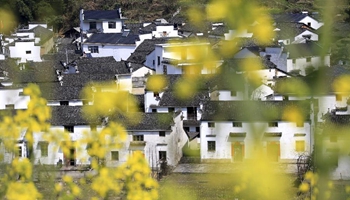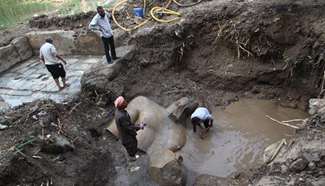BEIJING, March 10 (Xinhua) -- Wildlife is flourishing in southwest China's Tibet Autonomous Region as authorities strike a balance between ecology and development, said a government report and officials.
Tibetan antelopes, wild yaks, Tibetan wild donkeys, black-necked cranes and other endangered species have experienced "notable growth" in population, according to a report by Yonten, director of the regional government's forestry department, released on Friday.
The report was distributed to participants taking part in a panel discussion held by the Tibet delegation at the annual session of the National People's Congress.
According to the report, there are more than 200,000 Tibetan antelopes -- nearly quadruple the number in 1995 -- as well as 90,000 wild donkeys and 10,000 wild yaks. The number of nearly extinct black-necked cranes also rose to around 7,000.
Tibet is home to 795 species of wild vertebrates, and boasts one of the largest population of medium-and large-sized animals among provincial-level regions in the country.
The wildlife population grew despite a tourism boom in Tibet, dispelling concerns that rapid tourism growth could threaten Tibet's fragile environment.
In 2016, tourism grew steadily, with annual tourist arrivals rising 15 percent to more than 23 million.
Yonten credited Tibet's relentless efforts to preserve forests, control desertification, and protect wetlands in recent years.
Tibet has 61 nature reserves, including 10 classified as state-level reserves. The region is also home to the Tibetan Antelope and Yak National Park, the country's first large-animal conservancy.
During the panel discussion, Tibetan officials said economic development in 2016 was "good and fast." The regional GDP grew 10 percent to 115 billion yuan (17 billion U.S. dollars), maintaining double-digit growth for the 24th year. The urban jobless rate was below 2.6 percent.
Tourism and culture industries registered strong growth, while more highways have become operational and railways are to be extended.
"When development clashes with the environment, we put environment protection first," said Losang Jamcan, chairman of the Standing Committee of Tibet Autonomous Regional People's Congress.
He said Tibet has established ecological "red lines" to guard against overdevelopment.
The efforts have paid off.
"Lhasa, for example, has the best air quality among 74 major Chinese cities," he added.
Yonten said Tibet's authorities have realized it is imperative to guard ecological red lines and refuse to sacrifice the environment for short-term development, even though it may slow GDP growth.












